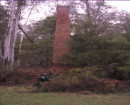Road Bridge over Rail (disused)
Off Kilmore Road,, RIDDELLS CREEK VIC 3431 - Property No B7196
-
Add to tour
You must log in to do that.
-
Share
-
Shortlist place
You must log in to do that.
- Download report


Statement of Significance
What is significant? The Gisborne Kilmore Road Bridge, built between 1859 and 64, and located on the Bendigo Railway and an important early cross-country route, is a rare early surviving, riveted wrought iron plate girder and bluestone road over rail bridge built at a sharp 50° skew. The abutments are faced with rusticated masonry with drafted edges, and feature parapets and engaged pilasters to either side of the opening. Six girders span the double rail tracks with wrought iron handrails intact on the south side.
Why is it significant? The Gisborne Kilmore Bridge is significant for aesthetic/architectural, historic and technical reasons at a State level.
Why is it significant? The Gisborne-Kilmore Road over rail bridge is of historical and technical significance as one of the oldest extant metal plate girder road bridges in Victoria in reasonably original form. The association of the bridge with the Melbourne Mount Alexander and Murray River Railway is significant, not only because of the large scale of public works associated with the construction of this line and its importance to the economic development of the colony, but also because of the key role that this project played in introducing the use of riveted wrought-iron plate girders to Victoria for both railway and road bridge construction. Prior to 1870 there were very few metal road bridges of any type built in Victoria and of the surviving examples attributed to this period which appear to retain their original riveted wrought-iron plate girders, all were associated with the construction of either the Melbourne-Bendigo, Ballarat-Geelong, and Melbourne-Brighton Railways.
The Gisborne-Kilmore Bridge, being the earliest of the form, may well be the prototype for other bridges along the line further north, which although varying in detail, follow a very similar pattern. The development of composite masonry and wrought iron bridge construction as demonstrated in this bridge may also reflect the crisis of the stone mason's strikes of 1858-61 and a subsequent change in bridge design which this event may have caused.
The Gisborne-Kilmore road over rail bridge is similar to several other metal road bridges over the same line. These are significant as a group which represents an outstanding historical event and engineering achievement. The comparatively intact condition and early date of the Gisborne-Kilmore Road Bridge provide the potential to yield important information about the introduction of this style of bridge on the Melbourne Mount Alexander and Murray River Railway and the to the whole of Victoria more generally.
It demonstrates the high engineering standards and fine workmanship which are characteristic of the Bendigo Railway and provides a marker for the importation and adaptation of British engineering and technology, based on the wealth of the gold rushes and increasing political and financial power of the new Victorian Colonial Government.
The combination of masonry abutments and metal girders in the design of the bridge is characteristic of the Bendigo Line which was engineered to British main-line standards under the influence of Andrew Clarke and given the stamp of approval by the British Inspecting Engineer Isambard Kingdom Brunel.
The road and rail routes are both of historical significance. The rail line was part of the first main country trunk routes linking the goldfields with the ports of Geelong and Melbourne (the other line being the contemporary Geelong-Ballarat line). The road route was an important early cross-country connection between some of the first inland towns (Kilmore and Gisborne) which increased in importance as a connection to the goldfields and between two of the main country routes - the Mount Alexander Road (now Calder Highway) and the Sydney road (Hume Highway).
The Gisborne-Kilmore Road Bridge is of aesthetic significance for the finely detailed and balanced execution of the design, which successfully blends the disparate materials of wrought iron and bluestone on a difficult sharp 50° skew angle. The design solves the challenging problems for early bridge engineers and designers of incorporating metal girders and results in a unique design solution which uses string courses to define structural components such as the foundation plinths and girder sills, and balances the relatively slender girder with parapet walls of a similar scale. The curved and tapered brackets of the handrails offer a delicate detail to balance the solidity of the rest of the structure. The stringcourses also carry the horizontal lines of the girders and handrails through the length of the structure, abutments and wing walls. In its original form the corrugated galvanised iron balustrade panels would have created a more solid profile to the structure.
Classified: 10/11/2003
File Note: Bridge has been by-passed and now stands alone. (06/05/2011)
-
-
-
-
ROAD OVER RAIL BRIDGE
 Victorian Heritage Register H1828
Victorian Heritage Register H1828 -
Road Bridge over Rail (disused)
 National Trust H1828
National Trust H1828
-
-








